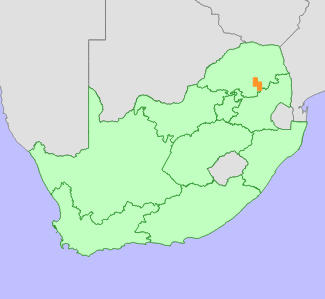|
Scientific Name | Polygala sekhukhuniensis Retief, Siebert & A.E.van Wyk |
Higher Classification | Dicotyledons |
Family | POLYGALACEAE |
National Status |
Status and Criteria | Vulnerable A4c |
Assessment Date | 2012/02/06 |
Assessor(s) | L. von Staden |
Justification | A range-restricted (EOO 1313 km²) edaphic specialist. A population reduction of between 30 and 40% is expected to be reached between 1996 and 2026, based on rates of ongoing habitat loss to mining and expanding settlements (generation length 10 years). |
Distribution |
Endemism | South African endemic |
Provincial distribution | Limpopo |
Range | Sekhukhuneland. |
Habitat and Ecology |
Major system | Terrestrial |
Major habitats | Sekhukhune Mountain Bushveld, Sekhukhune Plains Bushveld |
Description | Sparsely vegetated heavy metal rich soils on lower slopes and valley bottoms. |
Threats |
| The area where this species occurs is under heavy mining pressure and there has been extensive expansion in mining activities in the past 10 to 15 years. As a consequence, there has also been a large expansion of settlements, as labourers are drawn to work on the mines. Most of this species' localized, specialized habitat is under threat from destruction by slime dams and rock dumps associated with the mining industry (Siebert et al. 2010). |
Population |
Polygala sekhukhuniensis occurs within small areas of highly erodible, clay and mineral rich soils, to which it appears to be specifically adapted (Siebert et al. 2010). It has been recorded at many localities within the Sekhukhuneland region, but always in close association with this particular habitat, which is targeted for mining. At least 70% of known subpopulations were recorded in areas now densely populated or mining sites. Most subpopulations occur within Sekhukhune Plains Bushveld, which has been most severely affected by recent habitat destruction, with an 18% increase in transformation recorded between 1996 and 2009. In the southern part of its distribution range, some subpopulations have been recorded from Sekhukhune Mountain Bushveld, however, the rate of loss of montane vegetation is significantly lower, with a 10% increase in transformation since 1996. If current rates of habitat loss is to continue, transformation within montane areas is likely to reach 23% by 2026, and 41% on the plains. As this species is largely restricted to plains and lower slopes, it is therefore inferred that a population reduction is more likely to follow rates of habitat loss of Plains Bushveld, and that a reduction of between 30 and 40% is likely to be reached over a 30 year period (three generations).
|
Population trend | Decreasing |
Assessment History |
Taxon assessed |
Status and Criteria |
Citation/Red List version | | Polygala sekhukhuniensis Retief, Siebert & A.E.van Wyk | VU A4c | 2012.1 | |
Bibliography |
Siebert, S.J., Retief, E., Van Wyk, A.E. and Struwig, M. 2010. A new species of Polygala (Polygalaceae) from ultramafic soils in Sekhukhuneland, South Africa, with notes on its ecology. South African Journal of Botany 76(2):345-353.
|
Citation |
| von Staden, L. 2012. Polygala sekhukhuniensis Retief, Siebert & A.E.van Wyk. National Assessment: Red List of South African Plants version . Accessed on 2025/08/21 |
 Comment on this assessment
Comment on this assessment


